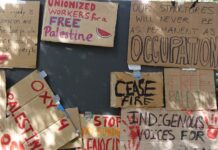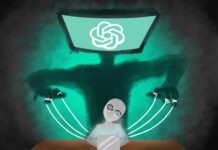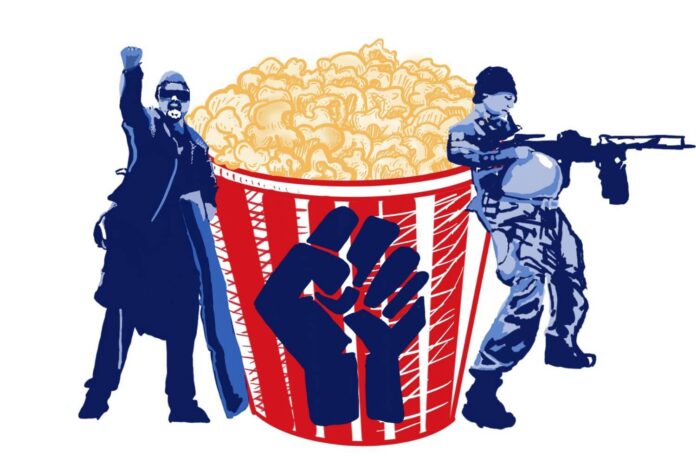“I wish I were part of the French 75,” I thought while sitting in my reclining chair at the AMC Americana, watching Paul Thomas Anderson’s newest film, “One Battle After Another” (OBAA). An epic action movie, OBAA follows members of a fictional revolutionary group, the French 75, as they go into hiding to avoid capture or death from the government. Without giving too much away, OBAA shows how the revolutionary mindset can be broken down and later revitalized through a new generation whose need to subvert and survive the U.S.’s dominant power structures requires new methods.
As I watched the film, I could not help but feel inspired. Here was a group of people, albeit fictional, at least doing something. The opening sequence shows the French 75 breaking people out of an ICE detention center, and later in the film, Benicio Del Toro’s character leads us into his underground-railroad-style shelter for migrants. It’s timely, to say the least, and it does not require a large mental leap to imagine reading an article tomorrow describing these very events taking place.
My second reaction to the movie, which took over swiftly after I experienced the first, was to feel guilty. All I had really done was watch a movie produced by a major studio with a $130 million budget. By paying for a ticket and sitting in a theater, eating popcorn and “decompressing” after a long day of school, I was just another supposed cog in the capitalist machine. And, by watching the movie, for a moment, yes, I felt like true liberation was possible. But was that feeling being spoon-fed to me by the culture industry? Is liberation actually possible, or was Hollywood trying to comfort me to believe it was, like parents keeping the magic of Santa alive?
Watching OBAA was a wonderful and enjoyable experience with its striking score composed by Jonny Greenwood, emotional and honest performances and high-paced momentum. But, watching films about people who fight for causes that are meaningful to you is not the same as fighting for that cause. OBAA risks placating its audience by allowing people to reassure themselves that somewhere out there, a group of revolutionaries could be causing chaos. I, as an audience member, however, am free to drink my soda, watch my values reflected on the silver screen and go back home comforted that I can log a film about liberation on Letterboxd. I did my part! (It is worth noting that the movie is peppered with moments of direct political action that are often covert if not illegal, and I would wager that most audience members are not looking to go on the run anytime soon.)
Despite my inclination to reflect cynically on OBAA, I have decided to do my best to return to the first instinctive feeling the movie sparked in me — motivation. As much as the market, culture and capitalism affected the making and message of the film, it is still important what we in the theater bring to it. As an audience, we can be affected by a film in unpredictable ways, distinct from the studio’s intended effect and even from the director/writer Anderson’s intentions.
One of the most powerful parts of OBAA to witness is its sense of solidarity. The French 75 (for the most part) have each other’s backs and trust one another to never back down in the face of the oppressive state. Benicio del Toro’s character also built a strong network of community members to keep his operation of helping immigrants avoid detainment up and running.
Many of the characters in the film exhibit resilience and a sense of hope that feels unreasonable considering their circumstances. One of my favorite moments in OBAA is when Benicio del Toro says to Leonardo DiCaprio’s bumbling, helpless but well-intentioned character, “Don’t go dark on me, Bob.” Here lies an interesting presentation of togetherness; there’s a mutual understanding of how bleak the circumstances are and how easy it is to feel discouraged. But by refusing to feel bad for themselves and refusing to lose their sense of humor, there is at least a chance of survival.
I’ve recently learned the term “political home.” It’s a place where, when times get rough, you have a group of people to make plans with, or at least to talk to. In the same way that you don’t wait until you’re starving to look up the nearest grocery store, you don’t wait until the political atmosphere is completely unbearable to know where and who you’re going to turn to. Whether it’s an established volunteer organization or a group of friends who meet up at a coffee shop to discuss the news, finding a political home is a starting point to build off of when it comes to working for liberatory action.
Slight spoiler ahead, but the last scenes of OBAA depict a teenage girl deciding to go to a protest. I have wondered what the purpose of 21st-century protest even is in recent years, such as the “No Kings” nationwide protests that have no clear demands and lack real societal disruption. I believe people need to make more tangible and formidable challenges to interrupt systems that cause harm. However, in-person gatherings are the beginning of political engagement, not the final manifestation. In a world like OBAA, where social media and cell phones can incur deadly consequences, real-world meet-ups are essential, which seems to contribute to the incredible energy between these revolutionary characters. To build a political home of any size, shape and level of political participation, it is impossible to describe the power of being present in the world together.
I’m grateful to have seen OBAA, and that a movie like OBAA can even be made right now. But, as Benicio del Toro’s character says to himself in the film when he gets pulled over by the police, “Let’s go to work.”
Contact Ava LaLonde at lalonde@oxy.edu
![]()



































